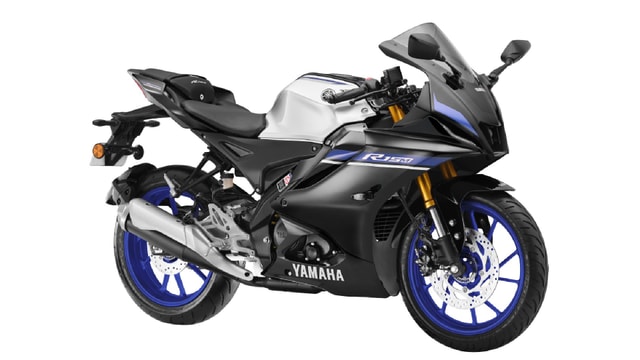BMW Motorrad Patents Reveal Active Aerodynamics

- The movable winglet design will offer more downforce and stability
- Engineers can offer more power without compromising on stability
- BMW's future models may feature active aerodynamic winglets
BMW Motorrad has filed patent applications in Germany showing an active aerodynamic winglet system for motorcycles. The system shown in the patent images reveal moving aerodynamic surfaces at both the front and the rear to alter the drag and downforce as needed. The system allows each of the four winglets to move independently under the control of the bike's on-board computer, using inputs like throttle position, brake force, speed, acceleration, lean angle and pitch to determine the best way to maximise grip without additional drag.
Also Read: Honda Patents Reveal New Aerodynamic Tail Section

The movable winglets are shown both on the fairing as well as on the suspension
The patent images show simple illustrations showing the outline of the motorcycle, with front and rear winglets mounted on the suspension, as well as on the bodywork, such as MotoGP inspired winglets. Such movable winglets won't be allowed in MotoGP, but BMW isn't looking to race in MotoGP, but possibly looking to introduce the system on a road-legal bike. And the position of the winglets on the suspension means the downforce will act directly on the wheels. The primary advantage is that sportbikes can be equipped with more power without implicating the bike's handling and stability, and that is what the winglets intend to do.
Also Read: Piaggio Files Patents For Aerodynamic Winglets

The active aerodynamic winglets will create downforce on the bike, offering more stability
BMW's moving winglets, whether mounted on the bodywork or the suspension, will allow the bike to create downforce in corners as well as straight lines, moving the left and right, front and rear winglets individually as required where the force is created. The design also includes the ability to move the winglets forwards or backwards through actuators, swinging them on a pivot at their mounting point like the swing-wings of some aircraft. The design also adds moveable surfaces to the ends of the winglets which can be extended to make them wider, increasing the winglets' influence on airflow over the bike.
Now, it's not clear if BMW will introduce all of the different mechanisms shown in the patents or it's just a clever way of covering the different ways the active aerodynamics can work, and trademark those uses. According to latest World Superbike regulations, movable bodywork will be permitted for use on the race track, provided they are available as standard equipment on the homologated road version as well. So, that could mean only one thing that future generation BMW S 1000 RR may well get active aerodynamic winglets like the ones shown on the patents.
Latest News
 Jaiveer Mehra | Jan 5, 2026Tata Punch Facelift Revealed Ahead Of January 13 LaunchFacelifted Punch gets styling elements inspired by its electric sibling and packs in more tech and a new engine option.1 min read
Jaiveer Mehra | Jan 5, 2026Tata Punch Facelift Revealed Ahead Of January 13 LaunchFacelifted Punch gets styling elements inspired by its electric sibling and packs in more tech and a new engine option.1 min read Carandbike Team | Jan 5, 2026Mahindra XUV 7XO Launch LIVE Updates: Price, Features, Specifications, Images1 min read
Carandbike Team | Jan 5, 2026Mahindra XUV 7XO Launch LIVE Updates: Price, Features, Specifications, Images1 min read Bilal Firfiray | Jan 5, 2026Volkswagen Reveals Electric Polo Cabin; Previews Future Interior PhilosophyVolkswagen has previewed its next-gen, customer-driven ID. cockpit in the near-production ID. Polo concept, blending intuitive physical controls, recycled materials, one-pedal driving and retro Golf-inspired digital dials.1 min read
Bilal Firfiray | Jan 5, 2026Volkswagen Reveals Electric Polo Cabin; Previews Future Interior PhilosophyVolkswagen has previewed its next-gen, customer-driven ID. cockpit in the near-production ID. Polo concept, blending intuitive physical controls, recycled materials, one-pedal driving and retro Golf-inspired digital dials.1 min read car&bike Team | Jan 5, 2026JSW MG Motor India Sells 46,735 Windsor EVs In CY2025; EV Sales Up By 111%The carmaker closed CY2025 with overall growth of 19 per cent, while its EV sales grew by 111 per cent compared to CY2024.2 mins read
car&bike Team | Jan 5, 2026JSW MG Motor India Sells 46,735 Windsor EVs In CY2025; EV Sales Up By 111%The carmaker closed CY2025 with overall growth of 19 per cent, while its EV sales grew by 111 per cent compared to CY2024.2 mins read car&bike Team | Jan 5, 2026Honda Elevate, City Offered With Discounts Of Up To Rs 1.76 Lakh In Jan 2026The new Amaze is being offered with benefits of up to Rs 60,000.1 min read
car&bike Team | Jan 5, 2026Honda Elevate, City Offered With Discounts Of Up To Rs 1.76 Lakh In Jan 2026The new Amaze is being offered with benefits of up to Rs 60,000.1 min read Carandbike Team | Jan 5, 2026Yamaha R15 Range Offered With Rs 5,000 DiscountAs part of Yamaha’s 70th anniversary celebrations, the brand has slashed prices for the R15 model range.2 mins read
Carandbike Team | Jan 5, 2026Yamaha R15 Range Offered With Rs 5,000 DiscountAs part of Yamaha’s 70th anniversary celebrations, the brand has slashed prices for the R15 model range.2 mins read
 Amaan Ahmed | Jan 3, 2026VLF Mobster 135 300 KM Review: Fun But FlawedA 125 cc scooter with Italian design and Chinese genes is a rare combination, and while some may be tempted to dismiss it because of its origins, the VLF Mobster shows 125s can also be exciting – but not without compromises.1 min read
Amaan Ahmed | Jan 3, 2026VLF Mobster 135 300 KM Review: Fun But FlawedA 125 cc scooter with Italian design and Chinese genes is a rare combination, and while some may be tempted to dismiss it because of its origins, the VLF Mobster shows 125s can also be exciting – but not without compromises.1 min read Preetam Bora | Dec 30, 2025TVS Orbiter Review: Real-World Performance and Range TestedThe TVS Orbiter is a promising electric scooter promising decent range, practicality and pricing. But is there any reason to avoid it? We spent a few days getting to know it better.9 mins read
Preetam Bora | Dec 30, 2025TVS Orbiter Review: Real-World Performance and Range TestedThe TVS Orbiter is a promising electric scooter promising decent range, practicality and pricing. But is there any reason to avoid it? We spent a few days getting to know it better.9 mins read Jafar Rizvi | Dec 24, 2025MG Windsor EV 38 kWh Long-Term Report: IntroductionThe Windsor EV has joined our garage, and before it settles into daily duty, I took it out to get a sense of what living with an electric car is like.4 mins read
Jafar Rizvi | Dec 24, 2025MG Windsor EV 38 kWh Long-Term Report: IntroductionThe Windsor EV has joined our garage, and before it settles into daily duty, I took it out to get a sense of what living with an electric car is like.4 mins read Seshan Vijayraghvan | Dec 23, 20252026 Kia Seltos Review: Formula Is Spot On, But Is The Timing Right?The 2nd-gen Kia Seltos has arrived, but it has the challenge of facing strong rivals like the Victoris and Sierra. The question is simple - Does it still have what it takes?9 mins read
Seshan Vijayraghvan | Dec 23, 20252026 Kia Seltos Review: Formula Is Spot On, But Is The Timing Right?The 2nd-gen Kia Seltos has arrived, but it has the challenge of facing strong rivals like the Victoris and Sierra. The question is simple - Does it still have what it takes?9 mins read car&bike Team | Dec 26, 2025Tata Punch EV Long-Term Second Report: Highway Performance, Pros & ConsAfter a week of living with the Tata Punch EV Long Range—including a proper Mumbai-Nashik highway test—we've learned what this little electric SUV is really made of.1 min read
car&bike Team | Dec 26, 2025Tata Punch EV Long-Term Second Report: Highway Performance, Pros & ConsAfter a week of living with the Tata Punch EV Long Range—including a proper Mumbai-Nashik highway test—we've learned what this little electric SUV is really made of.1 min read














































































































































